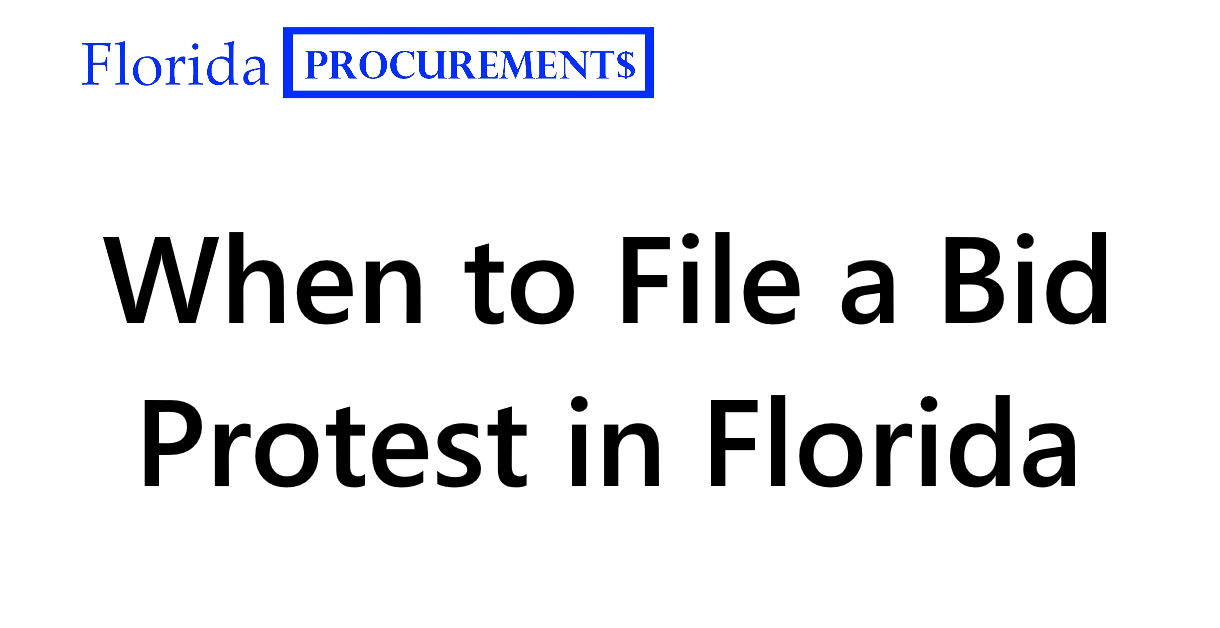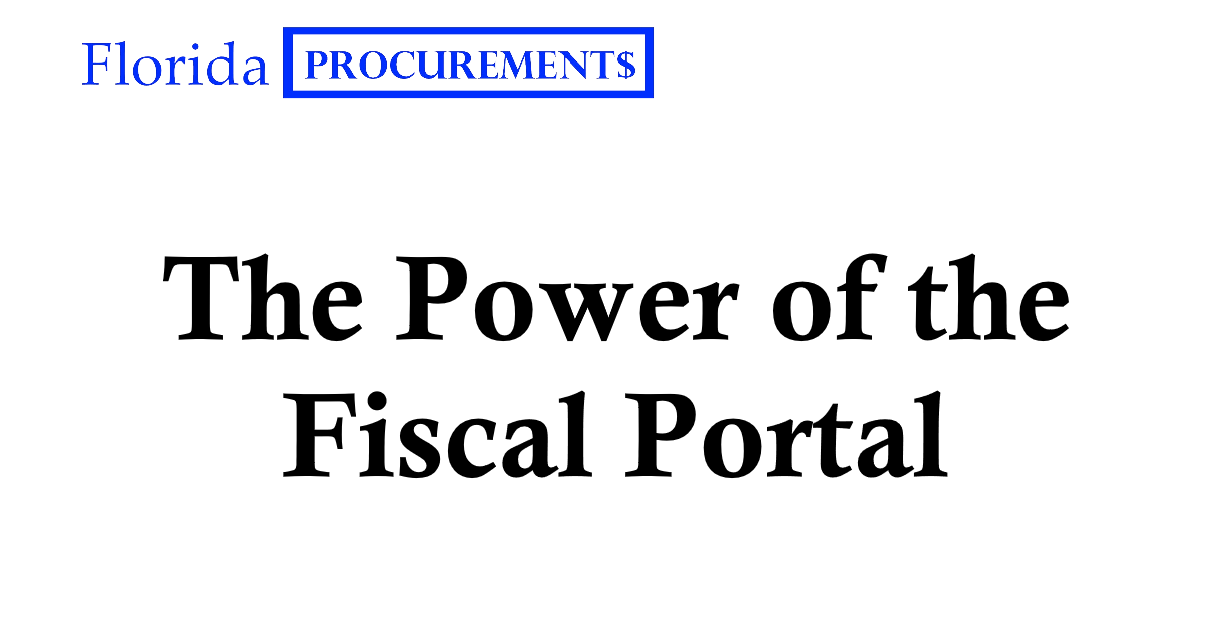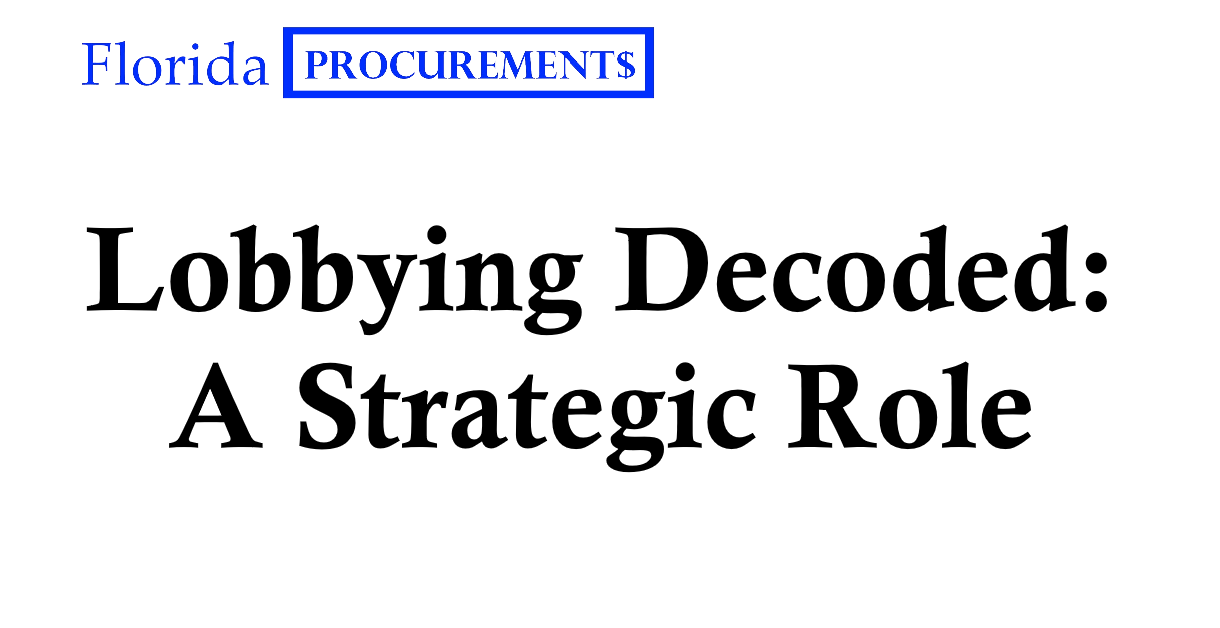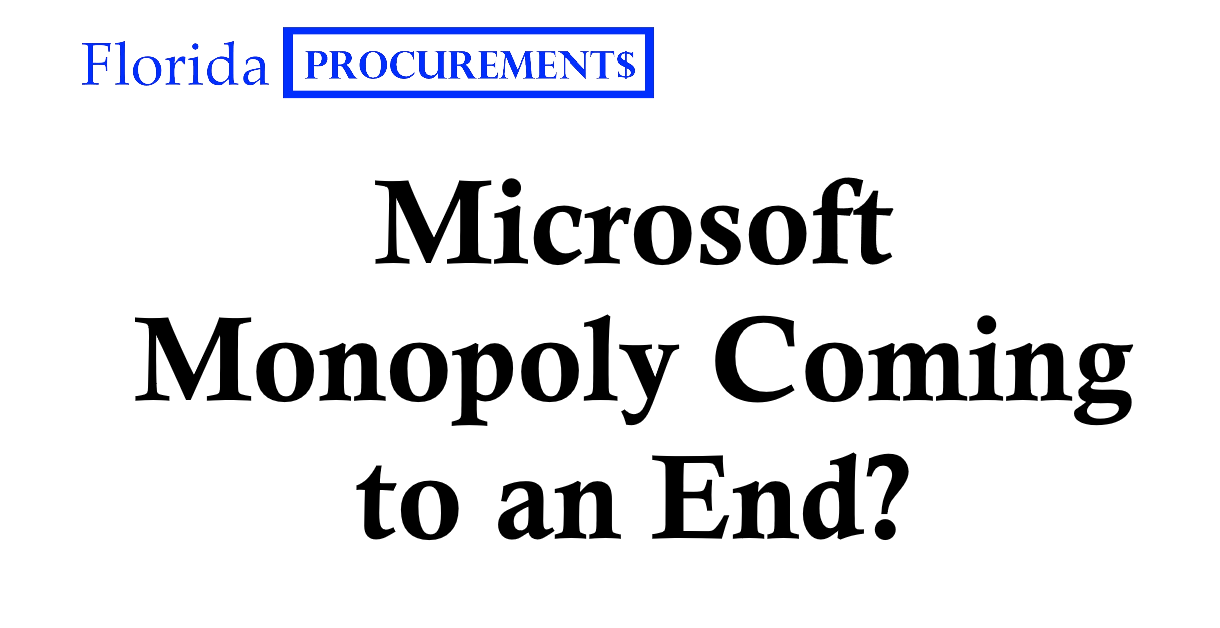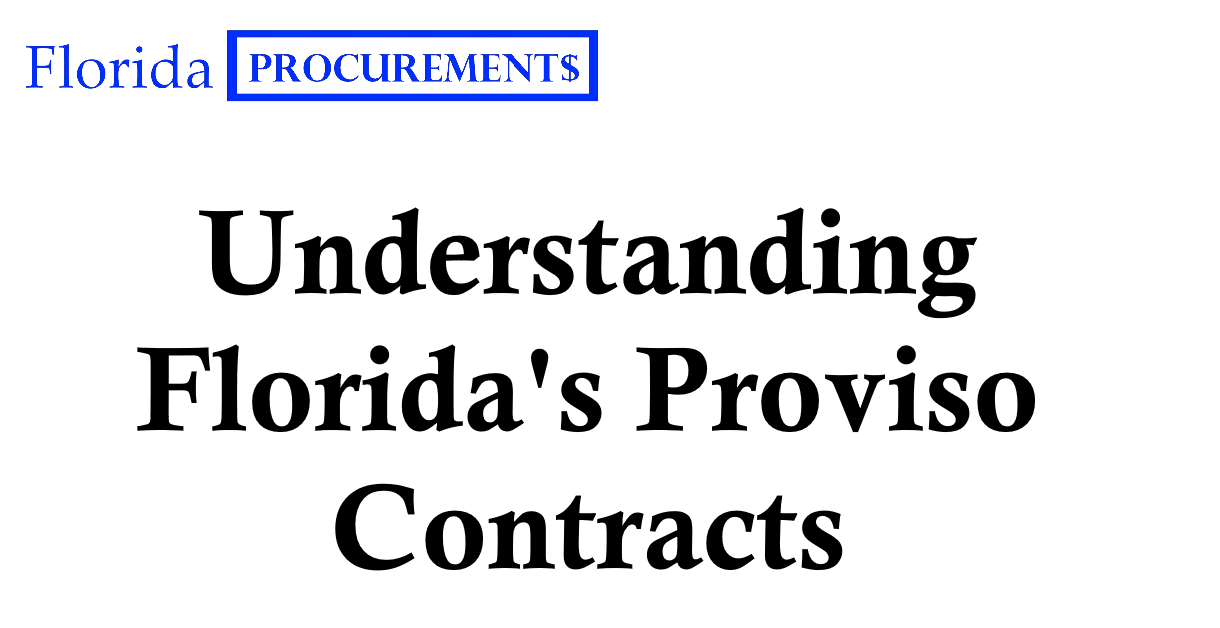
- February 25, 2025
- Sean Gellis
- 0
Welcome to FloridaProcurements.com (FlaProc), your authoritative resource for navigating Florida’s government contracting landscape, with particular focus on technology and transportation opportunities. FlaProc provides free, expert guidance to help companies identify and secure state contracting opportunities throughout Florida.
This resource is maintained by Attorney Sean Gellis of Gellis Law, PLLC, one of less than 75 attorneys Board Certified in State and Federal Government and Administrative Practice by The Florida Bar. Mr. Gellis brings unique insight to government contracting, having served as the Chief of Staff of the Florida Department of Management Services (DMS), General Counsel of the Florida Department of Transportation (FDOT), and Deputy General Counsel of the Florida Office of Insurance Regulation – positions that provided direct oversight of technology initiatives and issues of statewide importance. His record in bid protest litigation reflects the sophisticated advocacy and strategic thinking he brings to government contracting matters, particularly in complex transportation and technology procurements. Sean also leads Procurement Insider, a confidential subscription service that provides technology vendors with strategic intelligence and insider analysis of Florida government opportunities. Learn more about transforming your approach to government contracting at www.gellislaw.com/procurement-insider
FREE GUIDE: How to Find Your Next FDOT Project Opportunity Before Your Competition Does
As someone who oversaw FDOT’s $12 billion work program, I’m constantly asked how companies can identify lucrative opportunities before everyone else. Today, I’m sharing my insider playbook for navigating FDOT’s Work Program to discover projects months or even years before they hit the street.
Why the Work Program Matters
Let me start with something crucial: the Work Program isn’t just another boring government database – it’s your window into billions of dollars in future transportation projects. During my time as FDOT General Counsel, I watched how the most successful firms consistently used this resource to position themselves months, sometimes years ahead of their competition. This isn’t just about finding work – it’s about strategic positioning that puts you first in line.
Understanding What You’re Looking At
The Work Program covers a five-year span, but here’s what most people miss: it’s not just about future projects. It shows current work, planned projects, and even completed jobs. This historical data is gold for understanding FDOT’s patterns and preferences in your target market. By studying what has been funded before, you can better predict what will be funded next.
Finding Your Opportunities
When you access the Work Program you’ll have several search options. First, you need to access the FDOT Five Year Work Program Application.
You can search through either the prior five year work program or the next five year work program. The website offers you the ability to search by County, or Category.
FDOT also offers a downloadable version of the Work Program in .zip format.
If you want to search all payments made by a state entity to any specific vendor, you can do so by viewing DFS’s Transparency Florida website. This website is a valuable tool for understanding your competitors’ current government contracting situation and spotting gaps in the market you could fill.
Understanding Florida’s Legislative Budget Requests: Your Strategic Window into Agency Procurement
Having overseen major state agency budgets, I’ve seen firsthand how Legislative Budget Requests (LBRs) shape Florida’s procurement landscape. While many vendors focus solely on active solicitations, savvy companies understand that the real opportunities often emerge long before a procurement begins. This comprehensive guide will show you exactly how to leverage the LBR process for strategic advantage.
The Complete LBR Timeline: Understanding the Annual Cycle
The LBR process follows a predictable annual rhythm that smart vendors track closely. The below is an example of the LBR process during an odd-numbered year where the legislature convenes on the first Tuesday after the first Monday in March. For even numbered years, you will have to adjust the timeline accordingly because the legislature convenes on the second Tuesday after the first Monday in January.
July-August: Agencies begin internal development of their budget requests, gathering needs from divisions and stakeholders.
September-October: Agencies finalize and submit their official LBRs to the Governor’s Office and Legislature, typically by October 15th.
November-December: The Governor’s Office reviews agency requests and develops the Governor’s Recommended Budget.
January-February: The Governor releases their recommended budget shortly after the new year, signaling which agency requests received executive support.
March-April: Legislative session begins, with appropriations committees reviewing both the Governor’s recommendations and original agency requests.
May-June: Final budget negotiations occur, culminating in the General Appropriations Act, which may include items from agency LBRs that weren’t in the Governor’s recommendations.
Understanding this cycle allows you to identify strategic intervention points where your company can provide value.
Inside Agency LBRs: What They Actually Contain
During my time as a state agency leader, I found that most vendors don’t understand what information LBRs actually provide. Each LBR typically includes:
- Narrative justification explaining why the funding is needed
- Expected outcomes and deliverables the agency plans to achieve
- Cost breakdowns showing how funds will be allocated
- Implementation timelines for the requested programs or purchases
- Connections to agency strategic plans and state priorities
These elements provide crucial intelligence about not just what agencies want to buy, but why they need it and how they plan to implement it.
From Agency Wish List to Governor’s Budget
The journey of an LBR is more complex than many realize. Agencies submit their requests through a rigorous process that ultimately lands on the Governor’s desk. The Governor’s office then reviews these requests, deciding which ones make it into the recommended budget presented to the Legislature.
During my time as a state agency leader, I watched many solid LBRs get held back from the Governor’s budget recommendations. But here’s an interesting twist: the Legislature, with its independent authority, sometimes funds these “rejected” requests anyway. They understand that agencies wouldn’t have requested the funding without genuine need.
This creates a secondary opportunity path for vendors who closely track both the Governor’s recommendations and the original agency requests.
How Different Agencies Approach LBRs
Not all agencies approach the LBR process identically. Understanding these differences can help you better interpret their requests:
Large agencies (like FDOT, DCF, or DOH) typically submit numerous, detailed LBRs targeting specific program areas. Their requests often reflect multi-year strategic plans.
Smaller agencies may submit fewer, more comprehensive requests that encompass multiple needs within a single LBR.
Technology-focused requests often appear across multiple agencies but may be coordinated through Florida Digital Service. These frequently include implementation timelines that telegraph when procurement will likely occur.
Infrastructure-related LBRs typically include longer implementation periods and more detailed cost breakdowns, providing excellent advance planning information.
Strategic Opportunities for Vendors
Let me share something I learned watching successful companies navigate this process: LBRs offer two distinct strategic advantages for vendors.
First, they provide advance intelligence about agency needs. When an agency requests funding for specific technology, services, or infrastructure, they’re telegraphing future procurement opportunities. Smart vendors use this information to prepare comprehensive solutions long before the first procurement notice appears.
Second—and this is where real strategic thinking comes in—savvy vendors sometimes work collaboratively with agencies during the LBR development phase. While maintaining appropriate boundaries, companies can help agencies understand innovative solutions to their challenges, potentially influencing how future needs are defined and funded.
Finding and Accessing Agency LBRs
One practical challenge many vendors face is simply knowing where to find LBR information. Here’s how to access these valuable documents:
- Agency websites – Many larger agencies publish their LBRs directly on their budget or transparency pages
- Florida Fiscal Portal (http://floridafiscalportal.state.fl.us) – Contains comprehensive budget documents including agency LBRs
- Legislative websites – Both the House and Senate appropriations committees publish agency budget requests
- Public records requests – For agencies that don’t proactively publish their complete LBRs
The most valuable information often comes from comparing an agency’s original LBR with what ultimately appears in the Governor’s recommendations and final appropriations.
From LBR to Procurement: Connecting the Dots
Here’s where strategic insight becomes particularly valuable: understanding how an LBR eventually translates into a procurement opportunity.
When an agency receives funding for an initiative outlined in their LBR, they typically follow a predictable path:
- Initial planning phase (1-3 months after budget approval)
- Requirements gathering (often 3-6 months after approval)
- Procurement strategy development (typically 6-9 months after approval)
- Solicitation release (commonly 9-12 months after approval)
This timeline varies by agency and project complexity, but understanding this progression helps you prepare effectively and engage at the right moments.
Navigating Compliance Concerns
Now, I know what some of you are thinking: doesn’t early involvement create procurement integrity issues? Here’s why the LBR phase is different: it occurs well before any procurement activities begin, typically focusing on broad agency needs rather than specific procurement requirements.
That said, vendors should always:
- Maintain appropriate professional boundaries
- Focus on agency needs rather than specific solutions
- Document all interactions
- Respect procurement integrity rules
- Understand timing considerations
When the LBR process transitions toward actual procurement, be increasingly cautious about communications and ensure all interactions follow proper channels.
Common Pitfalls to Avoid
Through my years overseeing agency procurement, I’ve seen vendors make several common mistakes when trying to leverage LBR information:
Misinterpreting funding approval as guaranteed procurement – Even funded initiatives may change scope or approach before procurement.
Focusing solely on the Governor’s recommendations – Remember that the Legislature often funds items not in the Governor’s budget.
Waiting until appropriations are final – By then, you’ve lost valuable preparation time.
Over-aggressive engagement with agencies – This can create compliance concerns and damage relationships.
Failing to track implementation timelines – Missing the window when agencies are defining requirements.
Making the Most of LBR Intelligence
Want to leverage LBR information effectively? Here’s what I’ve seen work:
Monitor agency LBRs systematically. They provide valuable insight into:
- Upcoming technology needs
- Infrastructure projects
- Service requirements
- Program expansions
- Operational changes
Study the Governor’s recommended budget when it’s released. Understanding which LBRs made the cut—and which didn’t—helps predict both immediate opportunities and potential legislative funding initiatives. Admittedly, however, this can be a very difficult task without the right tools.
Track legislative budget developments. Sometimes the Legislature’s view of agency needs differs significantly from the executive branch’s perspective, creating unexpected opportunities.
Developing Your LBR Intelligence Strategy
To maximize the value of LBR information, consider developing a structured approach:
- Identify target agencies relevant to your products or services
- Create a tracking system for monitoring their budget requests
- Develop an annual calendar aligned with the budget cycle
- Assign responsibility for monitoring specific agencies or request types
- Establish evaluation criteria to prioritize potential opportunities
- Create response protocols for when relevant requests are identified
This systematic approach transforms LBR monitoring from an occasional activity into a strategic advantage.
Looking Forward
Understanding and monitoring LBRs can give vendors a significant strategic advantage in Florida government contracting. While they don’t guarantee procurement success, they provide valuable insight for companies serious about government business.
Smart vendors use this information to:
- Plan ahead for future opportunities
- Align capabilities with agency needs
- Develop comprehensive solutions
- Build strategic relationships
- Position for success
For those serious about government contracting in Florida, understanding the LBR process isn’t optional—it’s essential for strategic success.
Need strategic guidance on leveraging LBR opportunities or assistance with government contracting matters? Contact Gellis Law, PLLC. Drawing on experience as former agency counsel and executive leadership, we help clients navigate complex procurement opportunities effectively.


